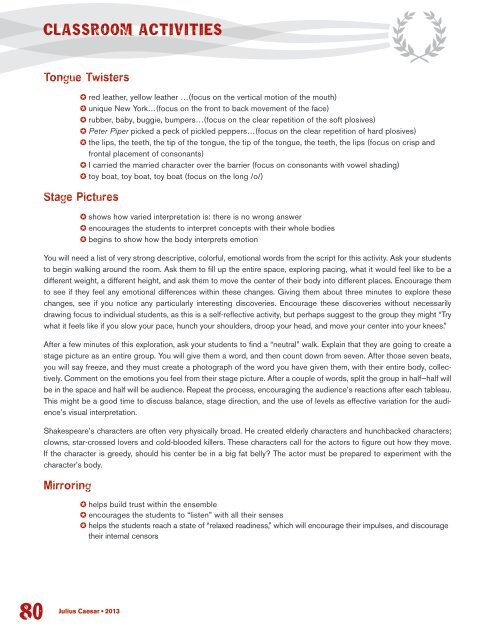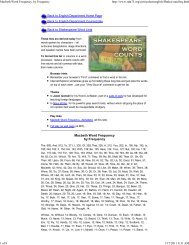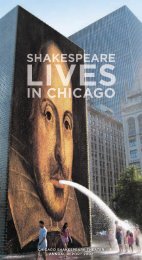Julius Caesar • 2013 - Chicago Shakespeare Theater
Julius Caesar • 2013 - Chicago Shakespeare Theater
Julius Caesar • 2013 - Chicago Shakespeare Theater
You also want an ePaper? Increase the reach of your titles
YUMPU automatically turns print PDFs into web optimized ePapers that Google loves.
80<br />
CLASSROOM ACTIVITIES<br />
Tongue Twisters<br />
✪ red leather, yellow leather …(focus on the vertical motion of the mouth)<br />
✪ unique New York…(focus on the front to back movement of the face)<br />
✪ rubber, baby, buggie, bumpers…(focus on the clear repetition of the soft plosives)<br />
✪ Peter Piper picked a peck of pickled peppers…(focus on the clear repetition of hard plosives)<br />
✪ the lips, the teeth, the tip of the tongue, the tip of the tongue, the teeth, the lips (focus on crisp and<br />
frontal placement of consonants)<br />
✪ I carried the married character over the barrier (focus on consonants with vowel shading)<br />
✪ toy boat, toy boat, toy boat (focus on the long /o/)<br />
Stage Pictures<br />
✪ shows how varied interpretation is: there is no wrong answer<br />
✪ encourages the students to interpret concepts with their whole bodies<br />
✪ begins to show how the body interprets emotion<br />
You will need a list of very strong descriptive, colorful, emotional words from the script for this activity. Ask your students<br />
to begin walking around the room. Ask them to fill up the entire space, exploring pacing, what it would feel like to be a<br />
different weight, a different height, and ask them to move the center of their body into different places. Encourage them<br />
to see if they feel any emotional differences within these changes. Giving them about three minutes to explore these<br />
changes, see if you notice any particularly interesting discoveries. Encourage these discoveries without necessarily<br />
drawing focus to individual students, as this is a self-reflective activity, but perhaps suggest to the group they might “Try<br />
what it feels like if you slow your pace, hunch your shoulders, droop your head, and move your center into your knees.”<br />
After a few minutes of this exploration, ask your students to find a “neutral” walk. Explain that they are going to create a<br />
stage picture as an entire group. You will give them a word, and then count down from seven. After those seven beats,<br />
you will say freeze, and they must create a photograph of the word you have given them, with their entire body, collectively.<br />
Comment on the emotions you feel from their stage picture. After a couple of words, split the group in half—half will<br />
be in the space and half will be audience. Repeat the process, encouraging the audience’s reactions after each tableau.<br />
This might be a good time to discuss balance, stage direction, and the use of levels as effective variation for the audience’s<br />
visual interpretation.<br />
<strong>Shakespeare</strong>’s characters are often very physically broad. He created elderly characters and hunchbacked characters;<br />
clowns, star-crossed lovers and cold-blooded killers. These characters call for the actors to figure out how they move.<br />
If the character is greedy, should his center be in a big fat belly? The actor must be prepared to experiment with the<br />
character’s body.<br />
Mirroring<br />
✪ helps build trust within the ensemble<br />
✪ encourages the students to “listen” with all their senses<br />
✪ helps the students reach a state of “relaxed readiness,” which will encourage their impulses, and discourage<br />
their internal censors<br />
<strong>Julius</strong> <strong>Caesar</strong> <strong>•</strong> <strong>2013</strong>




